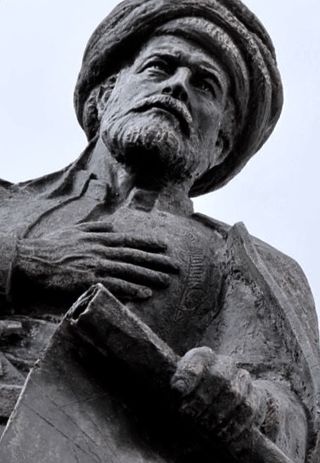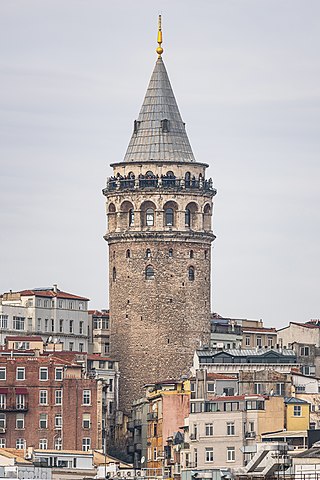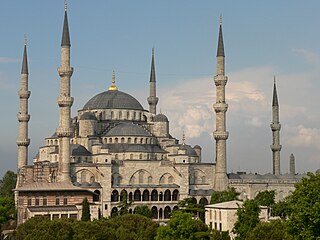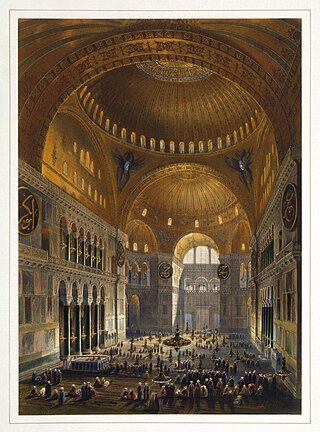Related Research Articles

Ahmed Muhiddin Piri, better known as Piri Reis, was an Ottoman navigator, geographer and cartographer. He is primarily known today for his maps and charts collected in his Kitab-ı Bahriye, a book that contains detailed information on early navigational techniques as well as relatively accurate charts for their time, describing the important ports and cities of the Mediterranean Sea.

The Galata Tower, officially the Galata Tower Museum, is an old Genoese tower in the Galata part of the Beyoğlu district of Istanbul, Turkey. Built as a watchtower at the highest point of the (lost) Walls of Galata, the tower is now an exhibition space and museum, and a symbol of Beyoğlu and Istanbul.

The Topkapı Palace, or the Seraglio, is a large museum and library in the east of the Fatih district of Istanbul in Turkey. From the 1460s to the completion of Dolmabahçe Palace in 1856, it served as the administrative center of the Ottoman Empire, and was the main residence of its sultans.

The Grand Bazaar in Istanbul is one of the largest and oldest covered markets in the world, with 61 covered streets and over 4,000 shops on a total area of 30,700 m2, attracting between 250,000 and 400,000 visitors daily. In 2014, it was listed No.1 among the world's most-visited tourist attractions with 91,250,000 annual visitors. The Grand Bazaar at Istanbul is often regarded as one of the first shopping malls of the world.

Fatih is a municipality and district of Istanbul Province, Turkey. Its area is 15 km2, and its population is 368,227 (2022). It is home to almost all of the provincial authorities but not the courthouse. It encompasses the historical peninsula, coinciding with old Constantinople. In 2009, the district of Eminönü, which had been a separate municipality located at the tip of the peninsula, was once again remerged into Fatih because of its small population. Fatih is bordered by the Golden Horn to the north and the Sea of Marmara to the south, while the Western border is demarked by the Theodosian wall and the east by the Bosphorus Strait.

Ottoman architecture is an architectural style or tradition that developed under the Ottoman Empire over a long period, undergoing some significant changes during its history. It first emerged in northwestern Anatolia in the late 13th century and developed from earlier Seljuk Turkish architecture, with influences from Byzantine and Iranian architecture along with other architectural traditions in the Middle East. Early Ottoman architecture experimented with multiple building types over the course of the 13th to 15th centuries, progressively evolving into the classical Ottoman style of the 16th and 17th centuries. This style was a mixture of native Turkish tradition and influences from the Hagia Sophia, resulting in monumental mosque buildings focused around a high central dome with a varying number of semi-domes. The most important architect of the classical period is Mimar Sinan, whose major works include the Şehzade Mosque, Süleymaniye Mosque, and Selimiye Mosque. The second half of the 16th century also saw the apogee of certain decorative arts, most notably in the use of Iznik tiles.

Malek National Museum and Library is a museum and national library in Tehran, Iran. Malek National Library and Museum Institution (MNLMI) is the first private museum of Iran, and one of the six large libraries holding the exquisite manuscripts. The MNLMI collection is a rich trove of the best manuscripts and Iranian historical artworks. The Institution is located in the historical precinct of “Bagh-e Melli”, that is considered the cultural-historical center of Tehran. Usually, the MNLM visitors are numerous university students and researchers, as well as tourists who enjoy its library and museum facilities. It is one of the biggest libraries of precious manuscripts in Iran, built by Hadji Hussein Agha Malek, the richest man in Iran at the time. He built it in a traditional Persian architecture style. One of the biggest contributors is Esat Malek Malek, Hadji Hussein Agha Malek's eldest daughter, who contributed to the museum's development.
The Ottoman archives are a collection of historical sources related to the Ottoman Empire and a total of 39 nations whose territories one time or the other were part of this Empire, including 19 nations in the Middle East, 11 in the EU and Balkans, three in the Caucasus, two in Central Asia, Cyprus, as well as the Republic of Turkey.

The Bosniak Institute is an institution of culture and scholarship in Sarajevo, Bosnia and Herzegovina. It has a museum and a gallery, a cultural centre and a library, a publishing house and a cultural centre. The institute is the result of its founder, Adil Zulfikarpašić, a donor (waqf), businessman, politician and promotor of cultural and educational life in Bosnia and Herzegovina. With his wife Tatjana Zulfikarpašić, he collected and preserved cultural heritage and contemporary production about Bosnia and Herzegovina, ranging from documents, photographs, postcards, maps, to books, encyclopaedias, journals, and other archival and library materials. The Bosniak Institute was founded in Zurich in 1988, and after the aggression against Bosnia and Herzegovina the entire stock was moved to Sarajevo, and opened in 2001.
The Oriental Institute in Sarajevo is an academic institute in Sarajevo, Bosnia and Herzegovina. It was founded in 1950 by the Socialist Republic of Bosnia and Herzegovina and is part of the University of Sarajevo. but it suffered significant destruction in 1992 during the Siege of Sarajevo.

The Mese was the main thoroughfare of ancient Constantinople and the scene of many Byzantine imperial processions. Its ancient course is largely followed by the modern Divan Yolu.

The Nuruosmaniye Mosque is an 18th-century Ottoman mosque located in the Çemberlitaş neighbourhood of Fatih district in Istanbul, Turkey, which was inscribed in the Tentative list of World Heritage Sites in Turkey in 2016.

The General Archive of Simancas is an official archive located in the Castle of Simancas, in the town of Simancas, province of Valladolid, Castile and León, Spain. It was founded in 1540, making this the first official archive of the Crown of Castile.

The Istanbul Tram is a modern tram system on the European side of Istanbul. The first section, the T1 opened in 1992, followed by the T2, which opened in 2006. In 2011, the T1 and T2 merged, with the line retaining the T1 name. The T4, T5 and the T6 lines followed, opening in 2007, 2021 and 2024 respectively.

The Fossati brothers, Gaspare and Giuseppe (1822–1891), were Swiss architects. They completed more than 50 projects in Turkey during the Tanzimat era. They belonged to the Morcote branch of the Fossati, a prominent Ticinese family with mentions in the historical record going back to the 14th century. Gaspare is most noted for his renovation of the Hagia Sophia in Constantinople, which virtually saved it from destruction.

The Archives du Maroc is an archive in Rabat, Morocco, on Avenue Ibn Battouta. Jamaâ Baida became director in 2011. It opened to the public in 2013. Among its holdings are materials related to the colonial French protectorate in Morocco.
References
- ↑ library.itu.edu.tr
- ↑ ifturquie.org
- ↑ Christopher Markiewicz and Nir Shafir, ed. (2013). "İSAM". Hazine: a Guide to Researching the Middle East and Beyond.
- ↑ kadineserleri.org Archived 2014-07-17 at the Wayback Machine
- ↑ "Nuruosmaniye Library".
- ↑ Uştuk, Hilal; Ahmet Esad Şani (13 January 2023). "Rami Kütüphanesi açıldı". Anadolu News Agency (in Turkish). Retrieved 14 January 2023.
- ↑ Christopher Markiewicz and Nir Shafir, ed. (2013). "Süleymaniye Library". Hazine: a Guide to Researching the Middle East and Beyond.